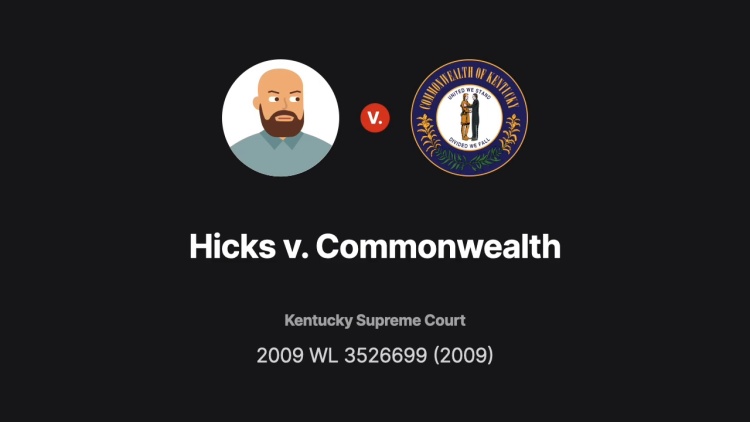Hicks v. Commonwealth of Kentucky
Kentucky Supreme Court
2009 WL 3526699 (2009)
- Written by Rose VanHofwegen, JD
Facts
Noah Hicks (defendant), Erroll Rogers, and two other coconspirators robbed Carroll Garvey, tied him up, put him in the trunk of a car, and drove around for about two hours. Garvey escaped but was shot once as he ran away. Garvey gave police his attackers’ names, specifically naming Hicks and Rogers as responsible for his injuries. When police searched Hicks’s home, Hicks said the gun was at Rogers’s house, where police then retrieved it. Hicks admitted to tying up Garvey, helping put him in the trunk, holding the gun when Garvey got out, and firing it when Garvey started running away. The state (plaintiff) tried Hicks, Rogers, and another coconspirator together. In his defense Hicks called inmate Ryan Spence, who met Hicks and Rogers in prison. Spence said that when other inmates asked what Rogers had done, Rogers said he “shot an Asian kid and put him in the trunk.” On cross-examination, the prosecutor asked Spence to show the jury a swastika tattoo on his arm. Spence refused. The judge held a conference out of the jury’s hearing. The prosecutor explained that the tattoo was relevant to Spence’s credibility because racial bias might have motivated Spence to incriminate Rogers instead of Hicks, as Rogers was African American and both Spence and Hicks were white. Hicks countered that the tattoo alone did not mean Spence was racist. The judge ordered Spence to show his tattoo, warning the jury to view it only as bearing on Spence’s credibility for “testimony that appears to be non-favorable to an African-American.” In addition, Spence’s cellmate testified that Hicks had offered to pay him and Spence for their testimony. The jury convicted Hicks of kidnapping with serious physical injury, robbery, and first-degree assault with a deadly weapon. Hicks appealed, arguing the judge should not have admitted the tattoo.
Rule of Law
Issue
Holding and Reasoning (Minton, C.J.)
What to do next…
Here's why 899,000 law students have relied on our case briefs:
- Written by law professors and practitioners, not other law students. 47,000 briefs, keyed to 994 casebooks. Top-notch customer support.
- The right amount of information, includes the facts, issues, rule of law, holding and reasoning, and any concurrences and dissents.
- Access in your classes, works on your mobile and tablet. Massive library of related video lessons and high quality multiple-choice questions.
- Easy to use, uniform format for every case brief. Written in plain English, not in legalese. Our briefs summarize and simplify; they don’t just repeat the court’s language.





